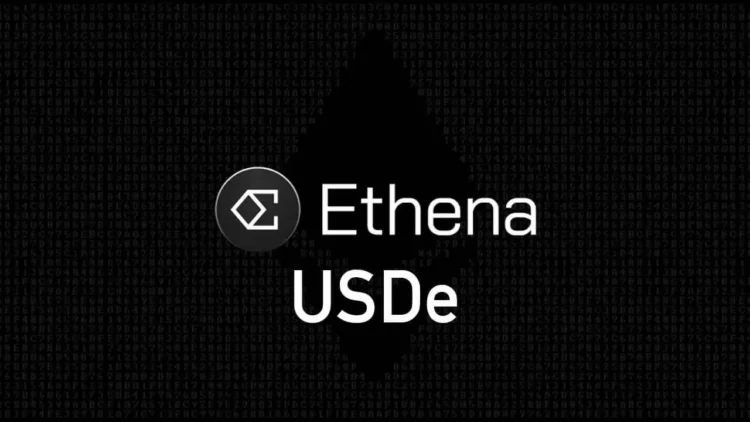DeFi is teeming with innovation, offering users permissionless access to lending, trading, and yield opportunities, but its reliance on highly volatile crypto assets continues to raise concerns around long-term stability.
One project aiming to solve this is Ethena, the team behind USDe, a synthetic dollar designed to bring scalable, censorship-resistant stability to DeFi without relying on traditional banking infrastructure.
But with so many stablecoin solutions already in the market and regulatory scrutiny mounting, the question remains: Can USDe truly deliver lasting stability in a volatile crypto space, or is it another experimental peg destined to break?
What Is Ethena’s USDe and How Does it Work?
Ethena is a protocol built on Ethereum that provides a crypto-native solution for money not reliant on traditional banking systems. Its core offering, USDe, is a synthetic dollar designed to maintain a stable value relative to the US dollar.
Unlike traditional stablecoins, USDe employs delta-hedging strategies using crypto assets and derivatives to mitigate volatility and ensure stability. This approach allows the DeFi stablecoin to function as a fully-backed, on-chain, scalable, and censorship-resistant form of money.
How USDe Works
Think of the DeFi stablecoin like a crypto version of a dollar, but not backed by a bank account full of actual dollars. Instead, it’s backed by a mix of crypto assets and smart financial strategies to keep its value steady around $1.

Here’s the step-by-step breakdown:
- You trade stablecoins for USDe
Let’s say you give $100 worth of USDT (a regular stablecoin). In return, you get about 100 USDe. A small fee is taken for gas and executing the trade, just like any crypto transaction.
- Behind the scenes, Ethena hedges risk
To keep USDe stable, Ethena instantly opens a short position (betting the price will go down) on crypto futures for the same amount you deposited. This cancels out any major price swings from the crypto assets that back USDe. This is called being “delta-neutral”—like having a backup plan for every risk.
- Assets are kept safe
The crypto you deposited isn’t sitting on some sketchy exchange. It’s held in off-exchange custody, meaning it’s locked in secure systems that reduce the risk of hacks or bankruptcies like FTX. Ethena never fully gives control of your backing assets to centralized exchanges—only what’s needed to make the hedge work.
- USDe can earn you rewards
If you want to earn yield, you can stake your USDe and convert it into sUSDe, which pays out rewards from the profits Ethena makes on its short positions (mainly funding rates from exchanges). In 2024, this paid around 18% APY, which is a solid return.
Role of the ENA Token and the “Internet Bond” Concept
The ENA token serves as the governance and utility token within the Ethena ecosystem. Holding ENA means you’re not just a passive investor; you actually get to help shape the future of the protocol. ENA holders vote on important stuff like who joins the Risk Committee, a group of experts that make big decisions about how Ethena runs. You don’t have to vote on every little thing yourself; you can delegate it to pros who live and breathe DeFi.
There have already been some big votes:
- Bringing SOL as a backing asset for USDe
- Choosing who handles real-world asset investments like BlackRock’s BUIDL.
If you lock up your ENA tokens, you receive sENA in return (just like a receipt token). This staked version comes with benefits:
- Earn rewards (starting with unclaimed airdrops from season 2)
- Qualify for future token drops from projects in the Ethena ecosystem—kind of like how holding BNB gives you perks across Binance tools.
- Ethereal, a new DEX launching on Ethena, has already promised 15% of its future token supply to sENA holders. That’s a pretty sweet incentive.
Ethena also introduces the concept of the “Internet Bond”, a novel financial instrument that combines yield from staked Ethereum with returns from funding and basis spreads in perpetual and futures markets. This bond functions as a dollar-denominated savings vehicle, offering users a stable and decentralized alternative to traditional savings accounts.
USDe vs. Existing Stablecoins
Here’s a clear side-by-side comparison of USDe and existing stablecoins:

Potential Benefits of USDe for DeFi
As the DeFi ecosystem continues to mature, USDe introduces several advantages:

Decentralized Nature and Censorship Resistance
Unlike centralized stablecoins such as USDT and USDC, which rely on traditional banking infrastructure and can be subject to regulatory freeze or blacklisting, the DeFi stablecoin is minted entirely on-chain using crypto-native assets.
Its architecture avoids centralized custodians, making it less vulnerable to government intervention and preserving the permissionless nature that DeFi was built on.
Capital Efficiency and Scalability Advantages
Traditional decentralized stablecoins like DAI require overcollateralization, which ties up more capital than necessary and limits growth. USDe, on the other hand, achieves a 1:1 backing using a delta-neutral hedging strategy, where staked ETH derivatives are paired with short perpetual positions to neutralize volatility.
This efficient use of capital enables greater scalability, allowing more users to participate without compromising the system’s integrity.
Improved Liquidity and Risk Diversification in DeFi
USDe introduces a novel form of decentralized collateral that is uncorrelated with centralized stablecoin risks. By expanding the types of stable assets available to protocols, the DeFi stablecoin helps diversify systemic risk while boosting liquidity pools across DeFi.
This can improve the performance of trading platforms, lending protocols, and automated strategies that rely on deep stable liquidity.
Use Cases: Trading, Lending, Savings Protocols
In trading, USDe can act as a reliable stable pair for volatile crypto assets, offering users confidence in price stability during swaps. For lending protocols, its on-chain and decentralized nature makes it a strong collateral option without the risks associated with central entities.
When staked as sUSDe, users can earn attractive yields from funding rate arbitrage, turning stablecoins from passive assets into income-generating tools suitable for DeFi savings products.
Challenges and Risks
While Ethena’s USDe offers various benefits, there are several challenges and criticisms that could hinder its long-term success and mainstream adoption.

Market Risks: Reliance on ETH and Perpetual Futures
USDe’s stability depends on using ETH as collateral and opening short positions in perpetual futures markets. If ETH markets experience sudden, extreme volatility or if perpetual futures platforms face outages or manipulation, the system could struggle to maintain its $1 peg or properly hedge risk.
This reliance means that disruptions in ETH’s price or the futures markets could directly impact the value and security of the DeFi stablecoin.
Smart Contract Vulnerabilities
Like all DeFi protocols, Ethena runs on smart contracts—automated code that controls how assets move and how USDe is minted or redeemed. Bugs or exploits in these contracts could lead to significant losses, hacks, or unintended behaviour.
Even with regular audits and security reviews, no code is immune to bugs, and exploits have affected even the biggest DeFi protocols in the past.
Potential for Depegging During Extreme Volatility
In highly volatile market conditions, the delta-neutral hedge strategy could break down temporarily if slippage increases or hedges cannot be executed quickly.
This may lead to a depegging event, where USDe trades below or above its $1 target. Maintaining the peg in extreme conditions depends heavily on how fast and efficiently the system can rebalance positions and respond to price changes.
Regulatory Risks
Even though USDe is designed to be decentralized, it still interacts with centralized exchanges for hedging purposes and relies on service providers for custody solutions.
As governments increase their scrutiny of crypto projects, Ethena may face regulatory pressure, especially around derivatives usage, stablecoin classification, or centralized exchange exposure. Future regulations could limit or restrict key parts of the protocol, affecting its growth or forcing it to change its operations.
Liquidity and Adoption Hurdles
USDe is relatively new compared to established stablecoins like USDT or USDC, meaning it still has to earn trust and gain adoption across DeFi protocols. Limited integrations or shallow liquidity pools could slow down growth and make it less attractive for users and developers in the short term.
Without broad support from DeFi platforms and users, the DeFi stablecoin may struggle to establish itself as a reliable medium of exchange or store of value within the ecosystem.
Can USDe Stabilize DeFi?
USDe brings a fresh approach to stablecoins by combining the scalability of algorithmic models with the reliability of crypto-collateral and delta-neutral strategies. Its design avoids centralized custody and fiat backing, aiming instead to create a censorship-resistant, fully onchain synthetic dollar that can scale without the limitations of USDT or USDC.
However, while USDe shows great promise, it still faces several challenges, such as its dependence on ETH and derivatives markets, as well as smart contract risks. Its innovative model also hasn’t yet been tested in prolonged bear markets or extreme volatility events, making it difficult to declare it a long-term solution just yet.
That said, Ethena‘s ability to maintain its peg and generate real yield using existing DeFi infrastructure positions USDe as one of the most compelling decentralized stablecoin experiments to date.
Disclaimer: This article is intended solely for informational purposes and should not be considered trading or investment advice. Nothing herein should be construed as financial, legal, or tax advice. Trading or investing in cryptocurrencies carries a considerable risk of financial loss. Always conduct due diligence.
If you would like to read more articles like this, visit DeFi Planet and follow us on Twitter, LinkedIn, Facebook, Instagram, and CoinMarketCap Community.
Take control of your crypto portfolio with MARKETS PRO, DeFi Planet’s suite of analytics tools.”





















